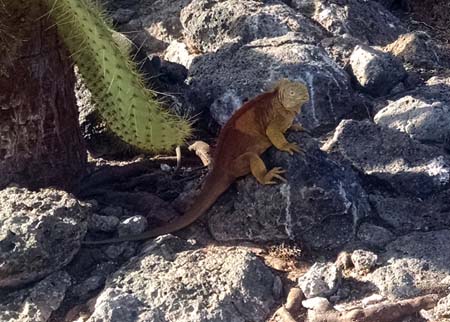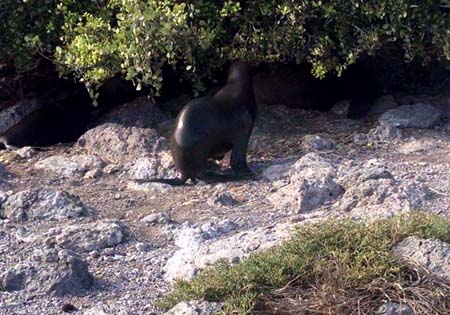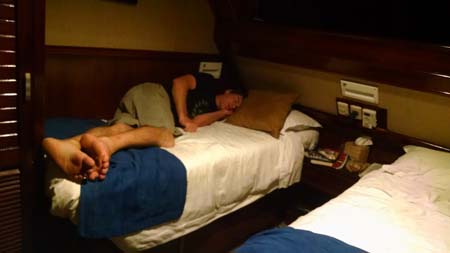|
|
|
along the Santa Cruz coast
Saturday, January 2 2016
location: between the Plaza Islands, off Santa Cruz Island, Galapagos, Ecuador
Little sparrow-sized petrels with white rumps (White-vented Storm Petrels?) had been following our boat all over the Galapagos, flitting up and down parallel to the surface of the waves, always staying about an inch above them and periodically dipping a beak in for something. This morning on our panga ride along the southern coast of the northmost Plaza Island, I saw a new species of Storm Petrel. This one had a body the size of a Blue Jay and long graceful wings. I asked what it was and was told simply "Storm Petrel." There was also a species of gull that was identified as the Swallow-tailed Gull. At the top of the 20 foot cliffs were a number of sea lions, whose ability to scramble up rocks was continuing to surprise.
There was a dry landing on the north side of South Plaza Island, though we had to wait for pangas for other boats to do their landings first, which was some of the reason we were looking at gulls, petrels, and yet more sea lions.
We'd mostly come to South Plaza Island to look at Land Iguanas, which were thick on the ground just above of the wave-washed rocks. According to our guides, some of those "rocks" were actually massive chunks of compressed sea lion excrement, and they could be very slippery when wet. Several of us slipped and some of us fell soon after getting out of the panga, especially those, like Peter!, with a more chaotic style of movement.
It was breeding season for the Land Iguanas, so some of them were yellowish-orange, and at one point we could see a pair of them gently fighting. The most interesting thing I learned about Land Iguanas today was that they do occasionally hybridize with Marine Iguanas, but the resulting offspring are sterile and have a much shorter lifespan (12 years, as opposed to 80).
Last time Gretchen and I had come to South Plaza Island, I'd insisted on walking it barefoot. But stepping on a sharp thorn soon after getting off the panga had convinced me to put on my Keens. So, unlike last time, I did not track my blood over the length of the circular trail.
Along the way, I jokingly told Chloe about Hoagie, my batty old mother, giving a sample of her catch phrase "Ah, fah chrissakes!" using am approximation of her nasal Boston-suburbs accent. Chloe found this amusing, and for the couple days remaining in the Galapagos, I'd hear her saying it. Her mother Leah wanted to know more, so Gretchen described Hoagie as "a real piece of work" and then detailed the worthless things stacked in piles in her hovel, which I haven't visited in two and a half years. Leah pictured my mother as smoking a cigarette while doing the quirky things described, but of course my mother was an anti-smoking zealot before not smoking was cool. Exaggerating, I described her marching up to smokers in restaurants and demanding they extinguish their fags. This reminded Gretchen of how, when she was a little kid, her parents used to send her to talk about her tiny sensitive lungs to thoughtless smokers (what other kind are there?) in airports.
Back at the Letty as we waited for the other panga to return from South Plaza, we were told we could go swimming. At the very back of the boat there is a low, narrow deck that resembles the edge of a pool, and there is even a pair of holes where a pool ladder can be temporarily installed. I put on my snorkel and joined Gretchen in the water, though it was a little disorienting to look down and see nothing at all except a smattering of fish, since the bottom lay well beyond visibility. I swam around looking at fish, though it wasn't long before I started having little problems with my snorkel and mask. In a conventional snorkeling environment, I might have swum over to the rocks and adjusted my equipment. Or if I'd been wearing a wet suit I could have fixed it out in the open water. But here, in the center of the channel between North and South Plaza Islands, the only place I could go was that ladder installed temporarilly in the back of the Letty. And even getting there suddenly seemed difficult; I was fighting a current. By now, the other panga had arrived from South Plaza and among its passengers were our oldest and frailest, the ones with bad knees and prescriptions for pain killers. I tried just staying in place while the panga delivered its passengers, but there is no impatience like the impatience one feels when there is a nagging sense that one is on the edge of drowning. I just couldn't wait for all those passengers to depanga. So, despite Hernan's best effort to keep all of us swimmers away from the back of the Letty, I looked at him, shook my head no, and swam to the ladder. It was good eight feet from where the panga was disgorging passengers, so the safety margin Hernan was trying to enforce was excessive. He clearly likes his ability to order us around, and I'm sure he was very displeased when I countermanded his order and got out of the water at that moment. But in my mind at the time, there really was no other course of action. After I was back on the Letty, some people asked if I was alright and I said that I was, that I'd just had a panic attack. When he expressed concern, I told Jeff, "On some level, that ocean just terrifies me."
The lunch buffet included a pot of noodles that probably weren't vegan, but given how much we like noodles and how few we'd gotten this week, we vegans went into "don't ask/don't tell" mode. The kitchen staff had also made faux fish cutlets from tofu and seaweed for the vegans, and though Gretchen hates seaweed and was disappointed, I was delighted. I cut the cutlets into little chunks, mixed them in with the probably non-vegan noodles, dumped on the aji hot sauce, and it was delicious. Later I went back for more noodles, but there were hardly any left. (There's always lots of meat left, probably because a lot of it is intended for the crew.)
This afternoon, the Letty sailed about 15 miles northwestward along the Santa Cruz coast, passing the occasional array of power-generating windmills. It dropped anchor between Baltra (the island with the airport on it) and North Seymour Island. Along the way, I read more of the Wolfram book PDF A New Kind of Science, taking a break at one point to draw my design for the flag of Ecuador in Photoshop (the version of Adobe Photoshop on that laptop is 7.0, which came out in 2002; it works great).
The first activity at North Seymour was a deep-water snorkel along the channel coast, starting in the east and following the current west. As you probably can guess, I stayed as close to the rocks as the panga drivers would allow, despite the danger of the rough waves smashing me against them. I was much less worried about that possibility than I was about my snorkel failing me without access to land. I wasn't wearing a wetsuit, so I lacked the buoyancy to fix my equipment in the open water. In practice, though, I found that the waves were bigger near the rocks and had a greater tendency to flood my snorkel and mask there than if I was out further, in a place that would require more of a swim to get to land. Also, while the fish near the rocks were colorful and interesting, I saw a whole different set of creatures when I looked down into deeper water. One of the best visions I had was of three enormous rays serenely flapping their wings along the bottom. At least one of these was an Eagle Ray with a black and white face that looked almost human. We'd seen a small Hammerhead Shark on the panga ride to the snorkeling spot, but I didn't see any sharks when I was snorkeling.
I would have left the water earlier if the pangas had put down their ladders, but I had to wait for the youngest of the kids to want to get out of the water. After them, I was one of the first adults out; I didn't want to push my luck after my fiasco swimming off the back of the Letty earlier today. But even coming in early, I only ended up snorkeling twenty minutes less than those still in the water, with one exception.
After everyone was in the pangas, we realized Gretchen's father was not among us. "Where's my father?" Gretchen shouted from the other panga. She's not a worrier, but she sounded worried. We looked out over the waves and saw nothing. He'd been wearing a life vest, so wherever he was, he should have been on the surface. Seeing nobody nearby or on the shore, the pangas speeded back towards the dropoff point at the east end of the channel, where it is constricted by flat, sandy Mosquera Island. I wasn't saying anything, but my inherent pessimism was starting to eat at me. Meanwhile the kids had no sense of the gravity of the moment, and they kept joking and giggling about the things that they found hilarious. Then we saw him, Gretchen's father, bobbing in the surf near the rocks. At first he could've been dead, and indeed he looked a little greyer than he should have. But then he raised his hand to signal he was okay. Evidently he'd missed the part of the pre-snorkeling directions where James told us to swim westward with the current.
Later we executed a dry landing on North Seymour Island, walking past the many sea lions of all ages to the frigatebird rookery. There, in low bushes encrusted with white frigatebird guano, were frigatebirds of all ages (including a number of skeletonized dead ones). The immature ones had white heads, and some of the males had inflated their red throat pouches. Hernan said that young males have golden heads, but we only saw a single gold-headed frigatebird in the entire rookery, causing Gretchen and me to wonder about the accuracy of that information. While we'd been taken to North Seymour mostly for the frigatebirds (and a few Land Iguanas), it was the sea lions that most of us cared about. There was a baby one there that our guides said couldn't have been more than "hours old." There was also a dead adult that had oozed into the sand and that most of the people in our group didn't even notice as they walked past.
This evening at the final briefing, we were given alcoholic drinks and a final farewell by the crew. After that, Hernan showed us a video he'd assembled from all the photos and video clips he'd been shooting. We were all there, mixed in with some stock pictures overlain with a light Hispanic-rock soundtrack. It was a great video, and I could see now why he liked to get photos of the kids all jumping in unison. I definitely wanted to have a copy, but it was ultimately just a part of the Letty money-making operation; copies of the video could be had for $50 each. We were also told about how to tip the crew, with a suggested baseline of $200/each for the week. We were also encouraged to hand-tip anyone on the boat who had gone beyond the call of duty. For us, that probably would have been Claudia, whose jobs included cleaning our rooms (a job no man in a macho culture will do), washing sand off our feet, and even navigating the boat. But we hadn't come with all that much cash; the need to bring obscene numbers of $20 bills was but one of several memos we hadn't gotten. Another was to hold onto the special Galapagos ticket we'd received when we'd arrived. Gretchen had assumed it was a receipt that could be thrown away, but no, we learned tonight, we were expected to produce it on the way out.
There's nothing like a guide laying it on thick about tips and the awesomeness of the crew to drive home the reality that we were just another twenty ugly Americans there to be separated from our cash. It was good that I'd somehow been denying this up until now.
An appetizer of sushi was served at the beginning of the last supper aboard the Letty. There was even a small amount of vegan sushi prepared for those of us who claimed to be vegan. But because the non-vegan sushi contained shrimp, a non-kosher ingredient, some of the sunny-day vegans who'd been happily eating chicken and fish all along suddenly transformed into actual vegans, at least for the purposes of sushi eating, because of the things that Yahweh demanded of them. Despite this, somehow I managed to eat an entire half of the vegan sushi all by myself. (Gretchen didn't want any due to its seaweed component.)
Gretchen and I had dinner with Jeff and Leah tonight, and it was much better than it had been on New Years' Eve. Jeff was being much less button-pushy and much more hilarious, and at one point Gretchen's mother came over to remark on the gales of laughter coming from our table. [REDACTED]

A Land Iguana in the shade of Prickly Pear tree on South Plaza Island.

A sea lion shade tree on South Plaza. Those "rocks" might actually be a compressed and fractured layer of sea lion feces. Click to expand the view.

Me on Gretchen's bed in our cabin (#4) on the Letty tonight. Unlike a similar picture taken onboard the Golondrina ten years ago, I was not sick in this picture (aside from a few nagging mouth sores).
For linking purposes this article's URL is:
http://asecular.com/blog.php?160102 feedback
previous | next |


